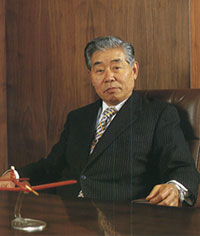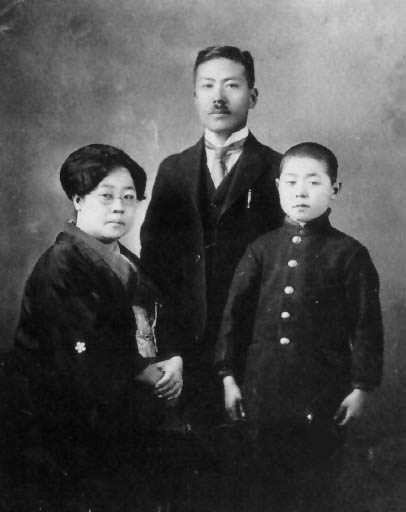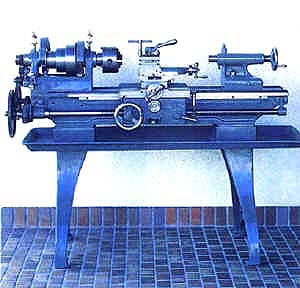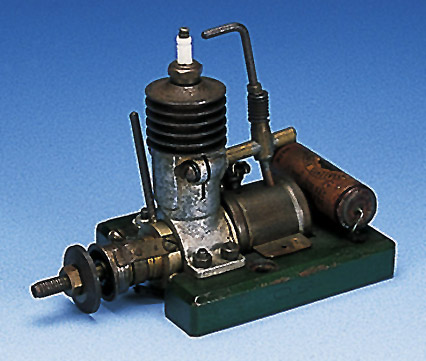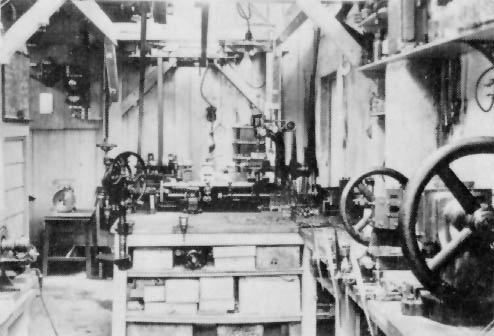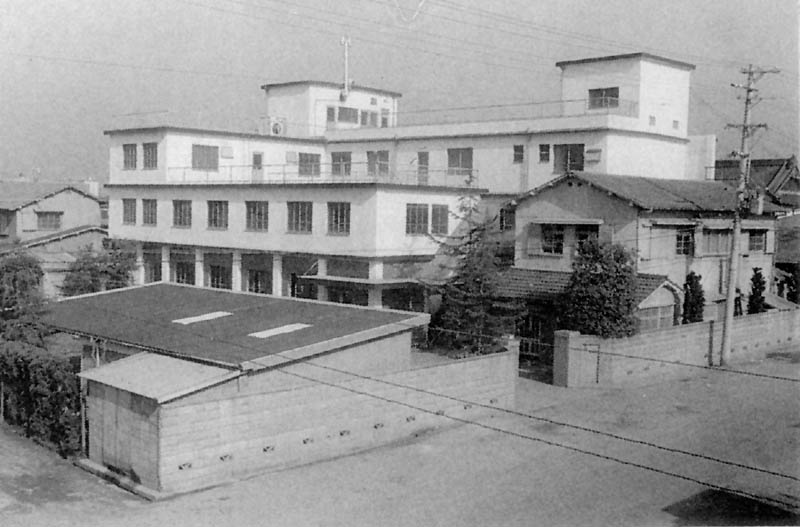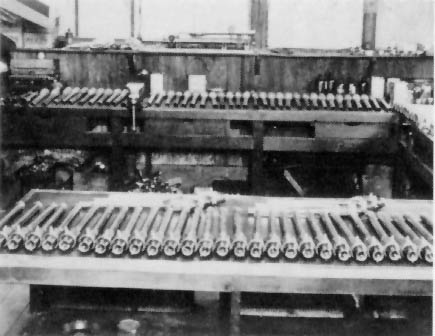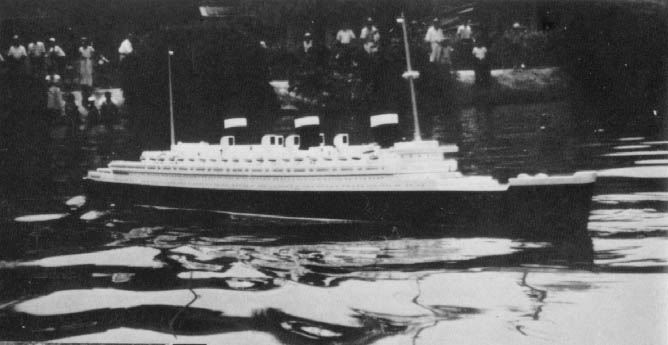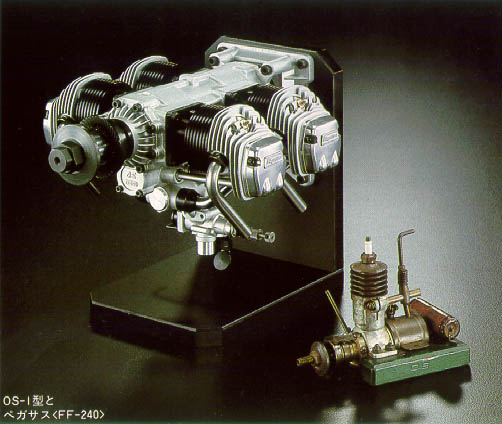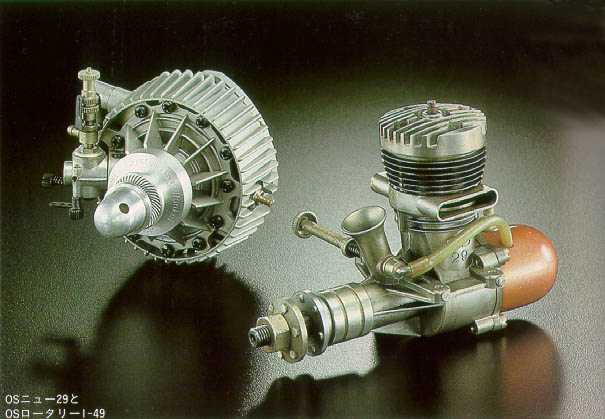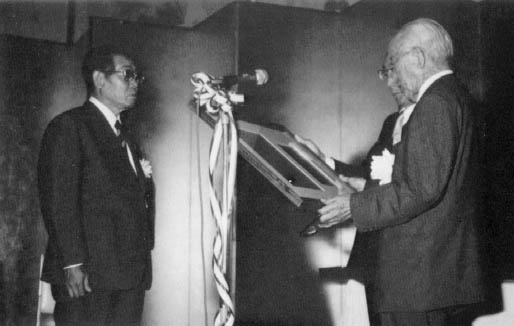1917—1992
The Innovator Behind O.S. Engines
Shigeo Ogawa was the founder and driving force behind the first highly successful model engines to come from Japan. (Photo courtesy of O.S. Engines Mfg. Co., Ltd., Japan.)
Model Engines and Steam Trains Make for a Successful Career
Born in 1917 in the Gifu Prefecture of Tajimi City, Japan, Shigeo Ogawa was fond of tinkering with machines from early childhood. When he became old enough, he attended an industrial school where he learned the fundamentals of engineering. As a student project he built a model engine that won a special award at a school science fair. This started him on a career in model engine building, eventually forming O.S. Engines Company.
O.S. started production of model engines in 1936, using a lathe that Mr. Ogawa had purchased for 100 yen. The company also began producing the “Type 1” model engine that same year at the suggestion of an American buyer, Paul Houghton. The line of model engines is still being produced today. In 1984, Mr. Ogawa won the prestigious FAI Paul Tissandier Diploma, one of the highest honors in the world of aviation. Mr. Ogawa passed away at the age of 75 in 1992.
Model Airplane Contests and Innovation
Shigeo Ogawa was a big promoter of contests, and he believed they were good for the industry. In his book, Mr. Ogawa wrote:
“The model airplane boom was at its peak around the 1950’s, and while a number of very large-scaled contests were held during that period, I personally did not particularly care for highly official and formalized competitions. I always believed that the true purpose of contests should reside in the practical improvement of the technical skills of the participants and not in the politics of contests themselves.”
“I also believe that the contests should not be encouraged merely for the purpose of publicizing one’s company products. Regardless of whether the airplane is equipped with an O.S. engine or not, if the model flies well and attracts attention, potential model airplane enthusiasts can be recruited. An increase in the number of enthusiasts, in turn, should contribute to the expansion of the whole model hobby industry. Therefore, I never have hesitated to support any type of contest and cooperate positively toward its success, throughout my career.”
Shigeo Ogawa’s first engine, the OS MAX-1 from 1936. (Photo Copyright 2002 Hobbico Inc. Used here with permission.)
Mr. Ogawa’s engines were noted for being very innovative, introducing many new milestones in model engine production. This included making the first model Wankel rotary engine (1970). He also was the first to offer a production supercharged model engine in 1990.
Always a driving force behind the company, Mr. Ogawa built up a team of experts to manage the business after his passing. In 1993, the O.S. Company joined the Futaba Corporation.
A Special Interest in Live Steam Trains
Mr. Ogawa’s other abiding interest besides model airplane engines was a love of live steam model railroading. As a student, he built a model live steam locomotive which received the top award at an exhibition. Within the model engineering fraternity, his self assembly kits for steam locomotives satisfied a demand from those who could afford but could not make their own engine.
This gave more enthusiasts the opportunity to own and operate a live steam engine locomotive. O.S. steam engines are of the highest quality. The steam engine business was Mr. Ogawa’s personal whim, made possible by the financial success of the model airplane engine business. In 1977, Mr. Ogawa established a showroom called the Osaka Live Steam Center, and three years later opened a similar showroom in Tokyo.
Starting in 1978, with the engine business in good hands with his expert staff, Mr. Ogawa decided to travel around the world and see some of the original locomotives that inspired his models. He also joined a live steam club in Los Angeles, and participated in a live steam locomotive gathering of over 100 engines in Griffith Park in 1985.
Mr. Ogawa wrote a book in 1986 that detailed his life and career. It is entitled, My Life and the Model Industry. The Joe Martin Foundation was given a copy of this book for our library, and much of the information published here came from its pages, along with most of the photos.
Mr. Ogawa poses with a model of the O.S.-made Porter Mogul. Steam trains were one of his special passions.
Engine Design and Production Highlights
In 1936, Mr. Ogawa started production with the Type 1 engine. About 200 1.6 cc engines were exported under the “Pixie” brand name. The Type 1 followed standard American model i.c. engine designs of the time. In 1937, it was succeeded by the much larger (6.92 cc) Type-2, and in 1938 the 7.45 cc Type-3 was born. This was an original O.S. design, which set the groundwork for future O.S. engine development.
In 1941, the O.S. Engine Mfg. Co. was established. In 1954, the first of a long line of O.S. ‘MAX’ engines, the MAX-1 29 and MAX-1 35, were developed. Those engines were followed by the MAX-1 15 in 1955.
In 1956, the MAX-1 15 powered model flown by Ronald Draper won the official FAI World Free-Flight Championship held in England. This drew worldwide attention to O.S. engines, and became the turning point that led, eventually, to the prominence of O.S. in the world market.
Production of a pulse jet model was begun in 1952. In 1954, the company started producing radio control equipment for models.
The first run of pulse jets on the O.S. production line in 1952. (Photo reproduced with permission from O.S. Engines Co. Ltd. and Hobbico Inc.)
In either 1968 or 1970 (both dates are listed), O.S. introduced the first production miniature Wankel rotary combustion engine—which was met with international acclaim. Refined over the years, it remains the only regular production model engine of this type.
In 1973, new O.S. designed production machinery was used to make the MAX-40SR. This was a 6.5 cc Schnuerle-scavanged engine, the first made in Japan. The 10 cc overhead-valve engine introduced in 1976 was the first volume-produced, four-stroke model aircraft engine.
Much quieter than current two-strokes, it was accepted for its “environmentally friendly” nature, and spurred many other manufacturers to introduce four-stroke engines. However, many were not as quiet as the O.S. engine.
The introduction of the first O.S. twin-cylinder engine, the FT-120, happened in 1979. This became the starting point for the current range of multi-cylinder scale-type power units—including horizontally-opposed four-cylinder, and radial five-cylinder engines often used on large flying scale models.
On the right is an early O.S. engine—a tiny “Pixie” Type 1 from 1936. On the left is a large multi-cylinder O.S. FF-240 Pegasus from 1986. A lot can change in 50 years! (Photo reproduced with permission from O.S. Engines Co. Ltd. and Hobbico Inc.)
In 1983, a new fully automated factory was built in Nara, Japan. The following year, a 1.8 km model railroad track was built next to the factory for running live steam model trains. In 1997, a model car circuit was added to the facility.
A special high-performance version of the 20 cc single-cylinder, four-stroke FS-120S was introduced in 1990 as the FS-120-SP. This engine included an O.S. designed Roots type supercharger—the first to be offered on a production model engine. In 1995, Mr. Giichi Naruke won the FAI F3A (aerobatics) World Championship using this engine.
Although Mr. Ogawa passed away in 1992, his legacy has been carried on by the O.S. company. In 1999, Mr. Ogawa’s expert staff, in conjunction with Futaba Corporation, developed an electronic fuel injection system for model engines. This has ensured that Mr. Ogawa’s vision of continued prominence for the company will continue to be carried on for years to come.
Special thanks to Terry Burnett of England for his research on Mr. Ogawa’s model steam locomotives.
Mr. Ogawa received the prestigious Paul Tissandier Diploma at this presentation ceremony in 1984. The diploma is presented by the FAI (International Aeronautical Federation) to persons who have made a significant international contribution to aviation progress. The award is being presented by former winner Dr. H. Kimura. (Photo reproduced with permission from O.S. Engines Co. Ltd. and Hobbico Inc.)
Learn more Mr. Ogawa’s company at the O.S. Engines website.
View more photos of the O.S. factory and product line.

